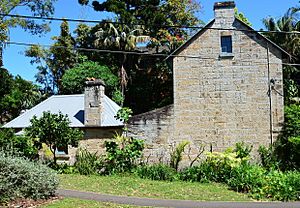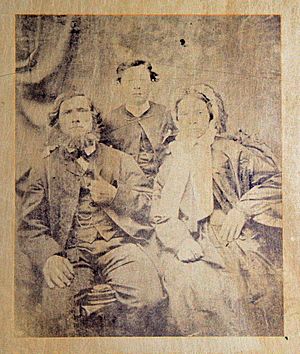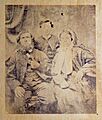Hooper Cottage facts for kids
Quick facts for kids Hooper Cottage |
|
|---|---|

Hopper Cottage, pictured in 2014
|
|
| Location | 17 Gilderthorpe Avenue, Randwick, City of Randwick, New South Wales, Australia |
| Built | 1847–1848 |
| Architectural style(s) | Victorian Georgian |
| Official name: Hooper Cottage | |
| Type | State heritage (built) |
| Designated | 2 April 1999 |
| Reference no. | 87 |
| Type | Cottage |
| Category | Residential buildings (private) |
| Lua error in Module:Location_map at line 420: attempt to index field 'wikibase' (a nil value). | |
Hooper Cottage is a very old house located at 17 Gilderthorpe Avenue in Randwick, a suburb of Sydney, Australia. It was built between 1847 and 1848. This special home is listed on the New South Wales State Heritage Register, which means it's an important part of history that needs to be protected. It was added to this list on 2 April 1999.
Contents
A Look Back: Hooper Cottage History
First People: Aboriginal History of Randwick
Before the 1780s, the land where Hooper Cottage now stands was used by local Aboriginal people. They used this area for fishing and important cultural activities. You can still find signs of their presence, like rock engravings and special grinding grooves.
The Aboriginal people are thought to have lived in the Sydney area for at least 20,000 years. The Cadigal people, who spoke Dharug, lived south of Port Jackson (Sydney Harbour) towards Botany Bay. The local clan in the Maroubra area was called "Muru-ora-dial." After Europeans arrived, the traditional way of life for Aboriginal people changed significantly.
Randwick's Early Days: Colonial History
In 1824, one of the first land grants in this area was given to Captain Francis Marsh. Later, in 1839, William Newcombe bought land near the current town hall.
The suburb of Randwick got its name from a town in England called Randwick, Gloucestershire. Two brothers, Simeon and James Pearce, suggested the name. Simeon was born in the English Randwick and came to Australia in 1841. He bought land and built his house, calling his property "Randwick." The Pearce brothers were very important in developing Randwick and its neighbour, Coogee.
Simeon Pearce worked hard to get a road built from Sydney to Coogee, which happened in 1853. He also helped make Randwick an official municipality in 1859. This meant the local government could collect money to improve the area.
In its early days, Randwick was a bit isolated from Sydney because of swamps and sandhills. Getting there was tough! But things changed when the Randwick Racecourse was established in 1863. This made Randwick a more lively and important place. Later, trams connected the suburb to Sydney, making travel much easier. Today, Randwick is a busy area with homes, businesses, and a lively community.
Hooper Cottage's Story: The Land and Its Owners
The land where Hooper Cottage stands was first given to Captain Marsh in 1824. In 1847, a market gardener named George Hooper bought about 26 hectares (65 acres) of this land. He planned to use it for orchards and market gardens, growing food to sell in Sydney.
In 1847, George Hooper built a small, single-storey cottage on his land. This was the first part of what would become Hooper Cottage. A year later, in 1848, he built a larger, two-storey house. The original small cottage was then used as a kitchen and living space for servants.
Around 1860, the street next to the cottage started appearing on maps as Figtree Avenue. In 1864, George Hooper moved to Queensland. He left his property to his wife, Mary, with Simeon Pearce as the trustee. George Hooper was a friend of the Pearce family, who were trying to attract wealthy people to Randwick.
For many years, the area around Hooper Cottage was full of market gardens and orchards. The people living in Hooper Cottage were often market gardeners themselves, supplying fresh produce to the city markets.
In 1887, Catherine Hooper, the widow of George's brother James, and her daughter Mary Ann McQuigan bought the cottage. Over time, the area became more developed. Around 1925, Orange Street, where the cottage is located, was renamed Gilderthorpe Avenue.
In the 1930s, Randwick became a more urban area, with more houses and fewer farms. Around the 1940s, some large fig trees were planted along Figtree Avenue, including two near Hooper Cottage.
The northern verandah (a covered porch) of the cottage fell off around 1968 but was rebuilt in 1980. In the late 1970s, people realized how important Hooper Cottage was. The Randwick Council and the Heritage Council of NSW worked to protect it. On 4 January 1980, a special order was placed to temporarily protect the property, followed by a permanent order on 12 February. Finally, on 2 April 1999, Hooper Cottage was officially added to the State Heritage Register.
What Hooper Cottage Looks Like
Hooper Cottage is a two-storey house built in the Victorian Georgian style. This means it has a simple, rectangular shape with a small roof. It has chimneys, windows, and doors that are placed evenly, making it look balanced.
The back of the house faces Gilderthorpe Avenue. This shows that the house was originally part of a much larger property of 26 hectares (65 acres).
The house has a sloped verandah at the back, which is the main entrance facing north. It also has a very rare old insurance plaque above a window on the north side.
Behind the main house, there's a separate, single-storey building made of sandstone. This was likely George Hooper's original cottage from 1847, which he later turned into a kitchen and servants' quarters after building the main house. There's an open courtyard between the two buildings.
Changes Over Time: Modifications and Dates
Hooper Cottage has seen some changes over the years:
- The street name changed from Orange Street to Gilderthorpe Avenue around the 1860s.
- The name Figtree Avenue first appeared on maps around 1860.
- The northern verandah fell off around 1968 and was rebuilt in 1980.
- A map from 1889 shows the kitchen and main house were separate. The kitchen had a bread oven, and there was an outdoor toilet.
- In 1994, major restoration work was done. This included rebuilding and extending the kitchen verandah. The roofs of both buildings were replaced, and new gutters and drainage systems were installed to prevent dampness.
- The plumbing in the bathroom and kitchen was updated.
- Some badly worn sandstone blocks were replaced, and a new stone window sill was added for the bathroom window.
Why Hooper Cottage is Special: Heritage Listing
Hooper Cottage is very important for several reasons:
- Historic Significance: It's one of the oldest buildings left in Randwick. It's the oldest farmhouse and the only remaining example of a working-class cottage from when Randwick was a rural area. It helps us understand what life was like in early Randwick and Sydney, especially for market gardeners who supplied food to the city.
- Social Significance: The cottage shows us how people lived in the 1800s. The difference between the main house and the simpler kitchen/servants' quarters shows how social status was viewed back then.
- Architectural and Aesthetic Significance: It's a rare example of a sandstone worker's cottage that was later used as a kitchen block. It's also a well-preserved example of simple Victorian Georgian architecture.
Because of its unique history and architecture, Hooper Cottage was officially listed on the New South Wales State Heritage Register on 2 April 1999.
Images for kids




